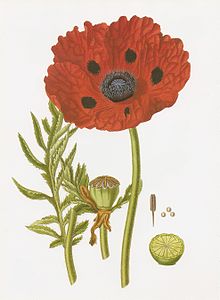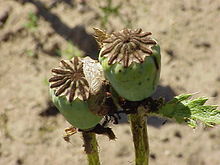Medicinal Poppy
| Medicinal Poppy | ||||||||||||
|---|---|---|---|---|---|---|---|---|---|---|---|---|

Medicinal Poppy ( Papaver bracteatum ) |
||||||||||||
| Systematics | ||||||||||||
|
||||||||||||
| Scientific name | ||||||||||||
| Papaver bracteatum | ||||||||||||
| Lindl. |
The medicinal poppy ( Papaver bracteatum ), also called Armenian poppy , is a plant from the poppy family (Papaveraceae). This plant species with up to 18 cm large, deep red flowers is native to mountain regions in northern Iran and the Caucasus . In the temperate latitudes, varieties and breeds of the medicinal poppy are used for ornamental plants . Because of its high content of the alkaloid thebaine , it is cultivated as a medicinal plant. It differs from the closely related and very similar-looking oriental poppy ( Papaver orientalis ) mainly in its scarlet flower color. In the addition to the name bracteatum , an important distinguishing feature is already mentioned, the three to eight bracteoles directly below the sepals . This does not mean the leaves that are attached directly to the flower stalk, which can also appear directly below the flower in Oriental poppies.
Description and ecology

Vegetative characteristics
The medicinal poppy grows as a perennial , herbaceous plant and reaches heights of up to 120 centimeters. From the basal leaf rosette grow several upright or ascending, robust stems 3 to 5 millimeters in diameter, each with a single flower bud at the tip. Alternately arranged leaves grow from five to eight nodes along the stem . They are divided into petiole and leaf blade. The leaves in the leaf rosette are 15 to 30 centimeters long and the stem is shorter towards the top. The gray-green, pinnate leaf blades are divided into lanceolate parallel segments and are serrated. The stems and leaves are hairy with long white bristles.
Generative characteristics
The flowering period extends from May to June. One to four sepal-like, 2 to 5 cm long, oval leaves ( prophylls ) grow below the flower, giving the plant its scientific name. At the end of the stalk there is a bowl-shaped, hermaphrodite flower sitting upright , which is radially symmetrical with a diameter of 10 to 18 centimeters . The broad, usually five, obovate, deep red or scarlet petals are 7 to 12 inches long. At the bottom they have a black spot about 1 centimeter in size that is "longer than wide". To the upper permanent ovary close the dark sitting stamens with the blackish violet anthers .
The seeds escape from the openings under the lid of the spherical to egg-shaped, 2 to 4 centimeter long pore capsule when the stem sways in the wind. The seeds ripen in July.
Chromosome number
The number of chromosomes is 2n = 14.
Similar species
The medicinal poppy is very similar to the oriental poppy ( Papaver orientale ), but it differs in the following features:
- the 3–8 bracts directly below the sepals. With the oriental poppy these are not present. This does not mean the foliage leaves that are sometimes attached to the flower stalk directly below the sepals, which are also occasionally found in the oriental poppy.
- the deep red color of the flower compared to the more orange-red flower of the oriental poppy
- the sturdy handle
- In the medicinal poppy, the flower buds are always upright, whereas in the oriental poppy they are slightly nodding (not as clearly pronounced as in the poppy ). The fully developed flower is then upright in both species.
The distribution areas of medicinal poppy and oriental poppy overlap in some places. This is where natural hybrids are formed.
Occurrence
Medicinal poppy seeds are native to northeastern Turkey , northern Iran , Armenia , Azerbaijan and southern Russia . It grows in dry steppes and mountains at altitudes between 500 and 2000 meters. It thrives best on soils of volcanic origin.
Botanical history
The drug was introduced to Europe in 1818 by Fischer , an employee of the Imperial Botanical Garden in St. Petersburg . The seeds presumably came from the Caucasus . In 1821 John Lindley wrote the first description .
use
The decorative varieties are used worldwide as an ornamental plant, often crosses with the very similar oriental poppy ( Papaver orientale ). The medicinal poppy is very easy to cultivate in sunny places.
The milky juice of the capsule fruit contains around 6% alkaloids , the most important representatives of which are oripavin and thebaine . Both are structurally related to morphine , which, however, could not be detected in the plant itself. Codeine and other analgesics can be produced industrially from the alkaloid thebaine . In cultivated cultivars of medicinal poppy seeds, thebaine accounts for up to 98% of the alkaloid content.
The World Health Organization (WHO) recommends the cultivation of medicinal poppy seeds for the production of morphine . In contrast to the opium poppy ( Papaver somniferum ), the medically necessary morphine can only be obtained from this type of poppy with the help of industrial processes. This is intended to make abuse more difficult. Today, however, we are far from successfully implementing this measure.
The Narcotics Act prohibits the unauthorized cultivation and distribution of all parts of the plant. With the second ordinance (2. BtMÄndV) in 1986 the use as an ornamental plant and the free distribution of the seeds were approved.
Individual evidence
- ↑ a b c d Masako Aragane, Daisuke Watanabe et al .: Rapid identification of a narcotic plant Papaver bracteatum using flow cytometry In: J Nat Med , 2014, 68, pp. 677–685, PMC 4158180 (free full text)
- ^ A b c d e Peter Goldblatt : Biosystematic Studies in Papaver Section Oxytona. In: Annals of the Missouri Botanical Garden. Vol. 61, No. 2, 1974, pp. 264-296, JSTOR 2395056
- ↑ Papaver bracteatum at Tropicos.org. In: IPCN Chromosome Reports . Missouri Botanical Garden, St. Louis
- ↑ a b B. Bös: GIFTPFLANZEN.COMpendium accessed in February 2008.
Web links
- Description at the Goethe University Frankfurt.
- Description in Mohn.tk .
- Vojtěch Holubec, Pavel Křivka: The Caucasus and its Flowers. Loxia, Pardubice 2006, ISBN 80-902541-3-6 ; Papaveraceae. ( Memento of July 10, 2007 in the Internet Archive ; PDF)
- About oriental poppies and other oddities. aufdemhoevel.de



